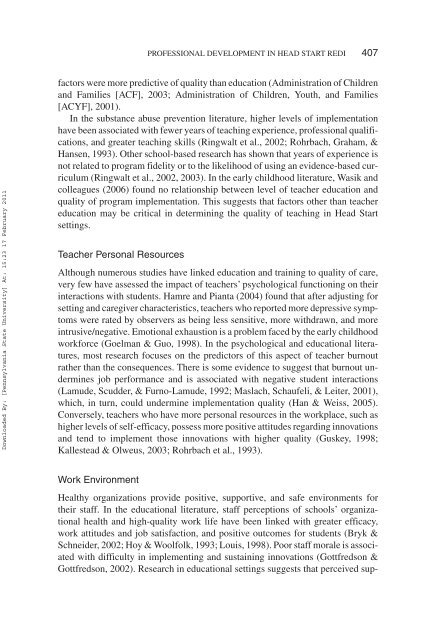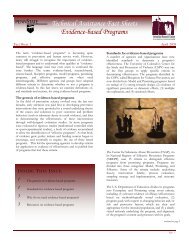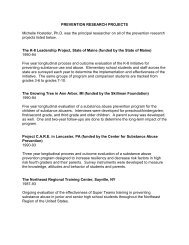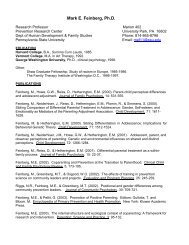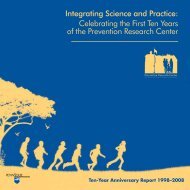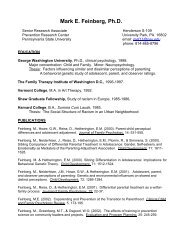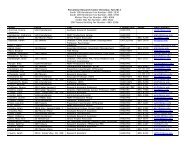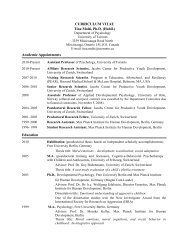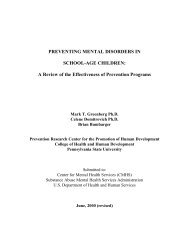Early Education & Development Individual Factors Associated With ...
Early Education & Development Individual Factors Associated With ...
Early Education & Development Individual Factors Associated With ...
You also want an ePaper? Increase the reach of your titles
YUMPU automatically turns print PDFs into web optimized ePapers that Google loves.
PROFESSIONAL DEVELOPMENT IN HEAD START REDI 407<br />
Downloaded By: [Pennsylvania State University] At: 15:23 17 February 2011<br />
factors were more predictive of quality than education (Administration of Children<br />
and Families [ACF], 2003; Administration of Children, Youth, and Families<br />
[ACYF], 2001).<br />
In the substance abuse prevention literature, higher levels of implementation<br />
have been associated with fewer years of teaching experience, professional qualifications,<br />
and greater teaching skills (Ringwalt et al., 2002; Rohrbach, Graham, &<br />
Hansen, 1993). Other school-based research has shown that years of experience is<br />
not related to program fidelity or to the likelihood of using an evidence-based curriculum<br />
(Ringwalt et al., 2002, 2003). In the early childhood literature, Wasik and<br />
colleagues (2006) found no relationship between level of teacher education and<br />
quality of program implementation. This suggests that factors other than teacher<br />
education may be critical in determining the quality of teaching in Head Start<br />
settings.<br />
Teacher Personal Resources<br />
Although numerous studies have linked education and training to quality of care,<br />
very few have assessed the impact of teachers’ psychological functioning on their<br />
interactions with students. Hamre and Pianta (2004) found that after adjusting for<br />
setting and caregiver characteristics, teachers who reported more depressive symptoms<br />
were rated by observers as being less sensitive, more withdrawn, and more<br />
intrusive/negative. Emotional exhaustion is a problem faced by the early childhood<br />
workforce (Goelman & Guo, 1998). In the psychological and educational literatures,<br />
most research focuses on the predictors of this aspect of teacher burnout<br />
rather than the consequences. There is some evidence to suggest that burnout undermines<br />
job performance and is associated with negative student interactions<br />
(Lamude, Scudder, & Furno-Lamude, 1992; Maslach, Schaufeli, & Leiter, 2001),<br />
which, in turn, could undermine implementation quality (Han & Weiss, 2005).<br />
Conversely, teachers who have more personal resources in the workplace, such as<br />
higher levels of self-efficacy, possess more positive attitudes regarding innovations<br />
and tend to implement those innovations with higher quality (Guskey, 1998;<br />
Kallestead & Olweus, 2003; Rohrbach et al., 1993).<br />
Work Environment<br />
Healthy organizations provide positive, supportive, and safe environments for<br />
their staff. In the educational literature, staff perceptions of schools’ organizational<br />
health and high-quality work life have been linked with greater efficacy,<br />
work attitudes and job satisfaction, and positive outcomes for students (Bryk &<br />
Schneider, 2002; Hoy & Woolfolk, 1993; Louis, 1998). Poor staff morale is associated<br />
with difficulty in implementing and sustaining innovations (Gottfredson &<br />
Gottfredson, 2002). Research in educational settings suggests that perceived sup-


